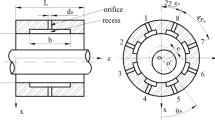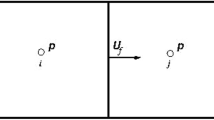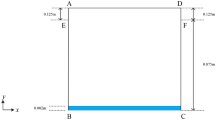Abstract
In this paper, a pressure-based coupled computational fluid dynamics algorithm for numerical analysis of all Mach number region flow is developed. For this purpose, an enhanced pressure based coupled algorithm was developed through the pressure–velocity coupled algorithm and the pressure-enthalpy coupled algorithm were combined. In additional, the Kurganov–Tadmor flux splitting scheme, which is mainly used in density-based solvers, was applied to a developed pressure-based coupled solver. To confirm the analytical ability of developed solver, the variety of Mach number flow problems were performed using the developed solver. It was confirmed that the developed solver had the similar analytical ability with that of the other numerical codes through the analysis of the shock tube problems. In order to verify the analytical ability for the variety Mach number flow region of the developed solver, 2D bump and nozzle problems and 3D missile and wing problems were analyzed and compared with results of experiments and other numerical analysis codes. It is confirmed that the analytical ability of developed solver in the all speed flow region is somewhat improved than the commercial analysis package and is similar to the density based in-house CFD code.

























Similar content being viewed by others
References
Patankar J (1980) Numerical heat transfer and fluid flow. CRC Press, Boca Raton
Kim TW, Gill JH (2017) Development of improved pressure-based solver algorithm for compressible flow. KSCFE 22(4):28
Kraposhin M, Bovtrikova A, Strijhak S (2015) Adaptation of Kurganov–Tadmor numerical scheme for applying in combination with the PISO method in numerical simulation of flows in a wide range of mach numbers. Proc Comput Sci 66:43–52
Darwish M, Moukalled F (2014) A fully coupled Navier–Stokes solver for fluid flow at all speeds. Numer Heat Transf Part B 65(5):410
Mangani L, Darwish M, Moukalled F (2016) An OpenFOAM pressure-based coupled CFD solver for turbulent and compressible flows in turbomachinery applications. J Numer Heat Transf Part B Fundam 69(5):413
Mangani L, Buchmayr M, Darwish M, Moukalled F (2017) A fully coupled OpenFOAM® solver for transient incompressible turbulent flows in ALE formulation. Numer Heat Transf Part B Fundam 71(4):313
Emans M, Frolov SM, Lidskii B, Posvyanskii V, Basara B (2012) SIMPLE-H: a finite-volume pressure-enthalpy coupling scheme for flows with variable density. Int J Numer Methods Fluids 69(1):206
Emans M, Zunic Z, Basara B, Frolov SM (2012) A novel SIMPLE-based pressure-enthalpy coupling scheme for engine flow problems. Math Model Anal 17(1):1
Xiao C-N, Denner F, van Wachem B (2017) Fully-coupled pressure-based finite-volume framework for the simulation of fluid flows at all speeds in complex geometries. J Comput Phys 346:91
Denner F (2018) Fully-coupled pressure-based algorithm for compressible flows: linearisation and iterative solution strategies. Comput Fluids 175:53
Sod GA (1978) A survey of several finite difference methods for systems of non-linear hyperbolic conservation laws. J Comput Phys 27(1):1–159
Lax PD (1954) Weak solutions of nonlinear hyperbolic equations and their numerical computation. Commun Pure Appl Math 7:159–193
Shu C-W (1990) Numerical experiments on the accuracy of ENO and modified ENO schemes. J Sci Comput 5(2):127–149
Choi Y, Merkle C (1993) The application of preconditioning in viscous flows. J Comput Phys 107:207–223
Han SH, Kim MH, Choi JY (2007) Migration from compressible code to preconditioned code. J Korean Soc Aeronaut Space Sci 35(3):183–195
Rieper F (2011) A low-Mach number fix for Roe’s approximate Riemann solver. J Comput Phys 230:5263–5287
Kim SD, Han SH, Shin JR, Choi JY (2012) Comparison of low-Mach number fixing methods for Roe scheme. In: Proceeding of KSAS spring conference, Rep. of Korea, p 4
Cuffel RF, Back LH, Massier PF (1969) Transonic flow field in a supersonic nozzle with small throat radius of curvature. AIAA J 7(7):1364–1366
Graves EB, Fournier RH (1974) Stability and control characteristics at Mach numbers from 0.20 to 4.63 of a cruciform air-to-air missile with triangular canard controls and a trapezoidal wing. NASA Technical Memorandum, NASA TM X-3070
Wee HC (2011) Aerodynamic analysis of a canard missile configuration using Ansys-Cfx. Naval Postgraduate School, Thesis, Monterey
NASA. NPARC Alliance Verification and Validation Archive. https://www.grc.nasa.gov/WWW/wind/valid/m6wing/m6wing.html
Acknowledgements
This study was supported by the Aerospace Core Technology Development Project (2017M1A3A3A04016580) of the Korea Research Foundation with government funding (Ministry of Science and ICT).
Author information
Authors and Affiliations
Corresponding author
Additional information
Publisher's Note
Springer Nature remains neutral with regard to jurisdictional claims in published maps and institutional affiliations.
Rights and permissions
About this article
Cite this article
Shin, J.R., Kim, T.W. Enhanced Pressure Based Coupled Algorithm to Combine with Pressure–Velocity-Enthalpy for all Mach Number Flow. Int. J. Aeronaut. Space Sci. 22, 489–501 (2021). https://doi.org/10.1007/s42405-020-00337-9
Received:
Revised:
Accepted:
Published:
Issue Date:
DOI: https://doi.org/10.1007/s42405-020-00337-9




